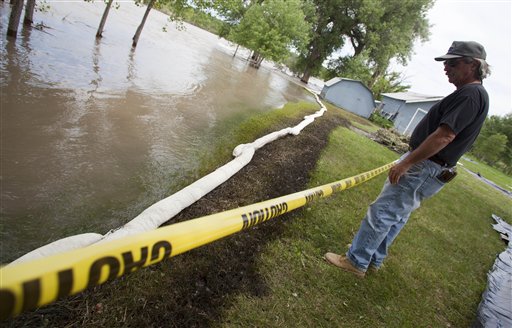
Jim Swanson surveys the oil impact on his property in Laurel, Mont., Tuesday July 4, 2011. An ExxonMobil pipeline near Laurel ruptured and spilled an estimated 1,000 barrels of crude into the Yellowstone.
On its 500-mile-plus route from Yellowstone County to eastern Washington, the Yellowstone Pipeline hugs the Yellowstone River, darts below the East Gallatin River and courses along the Missouri.
Farther west, the pipeline runs along the Little Blackfoot and Clark Fork rivers, carrying petroleum, diesel and jet fuel to customers across the region.
The 10-inch pipe is buried out of sight and is out of mind throughout those broad river valleys.
But as officials grapple with the oil spill in the Yellowstone River near Laurel, the fact is that oil and gas pipelines and storage areas along the banks of Montana's pristine waters are almost as common as trout fishermen.
And the spill has some people questioning whether regulators can do more to put a buffer between American fuel and American water.
For Daniel Lorenzetti, the spill has renewed his fears that a fuel storage area built in 2008 near Logan could spell trouble for the Gallatin River.
"We've now seen a first-hand example of what happens when a company that transports petroleum products near an important river has an issue," he said. "I would suggest that underneath the Yellowstone River is not the best place for a pipeline in the same way that creating a storage facility a stone's throw away from the Gallatin River would not be the best place to put those petroleum products."
Meanwhile, the Natural Resources Defense Council and other groups are using the spill as a springboard to lobby against the Keystone XL Pipeline project, a proposed pipeline that would run from the Alberta tar sands to Texas, crossing the Yellowstone River on the way.
But industry groups and regulators said that while plenty can be done to reduce the risk of oil spilling into rivers, it is impossible to build pipelines around rivers altogether.
"There's 170,000 miles of pipelines in this country for crude and refined oil. They cross rivers and they're going to need to cross rivers to get from supply areas to refineries and then from refineries to consuming areas," said Andy Black, who heads up the Association of Oil Pipe Lines, an industry group. "The rivers are unavoidable."
A spokeswoman for the company that operates the Logan storage facility said safety measures at the facility exceed federal requirements and that the company has built a "levy" around the facility in case fuel spills.
Tom Ring of the Montana Department of Environmental Quality's Major Facilities Siting Program said his bureau tries to minimize the areas where pipelines are near rivers. He said his bureau has pipelines cross rivers at right angles and moves them out of river valleys "in an expeditious manner."
However, his bureau only has jurisdiction over major pipelines like the Keystone XL, and with projects like that, "it is really hard to prevent it from crossing a stream at some place."
Once pipelines are in place, the U.S. Department of Transportation inspects them every three to five years, agency spokesman Damon Hill said.
And according to recent records, the pipeline coursing along Gallatin County's rivers, operated by ConocoPhillips, has had little issue: the company has received one warning stemming from operation of that pipeline, and no spills have been reported in the Bozeman area in the last five years.
"You're never going to get rid of the risk completely," said Scott Bosse of the river advocacy group American Rivers. "It's a matter of risk management. It's probably not practical to avoid rivers altogether, but they should absolutely be a serious consideration."
Story courtesy of the Bozeman Daily Chronicle, photo courtesy of Jim Urquhart of the Associated Press
All best,
______________________
Jason Frey
Agent
PureWest, Inc.
jason.frey@purewestproperties.com
http://www.linkedin.com/in/jasonfreylifewideopen

No comments:
Post a Comment